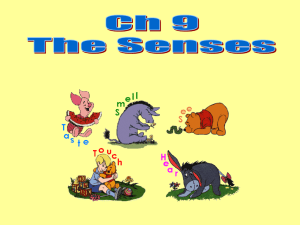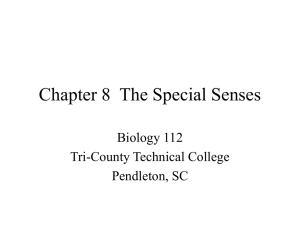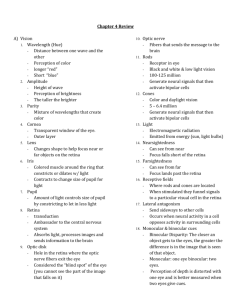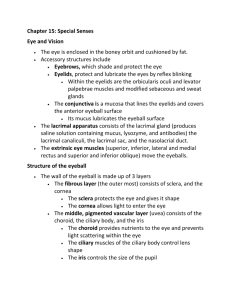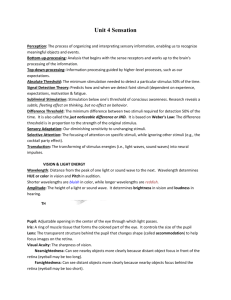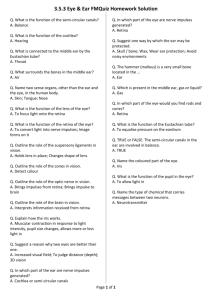Chapter 8 Special Senses
advertisement
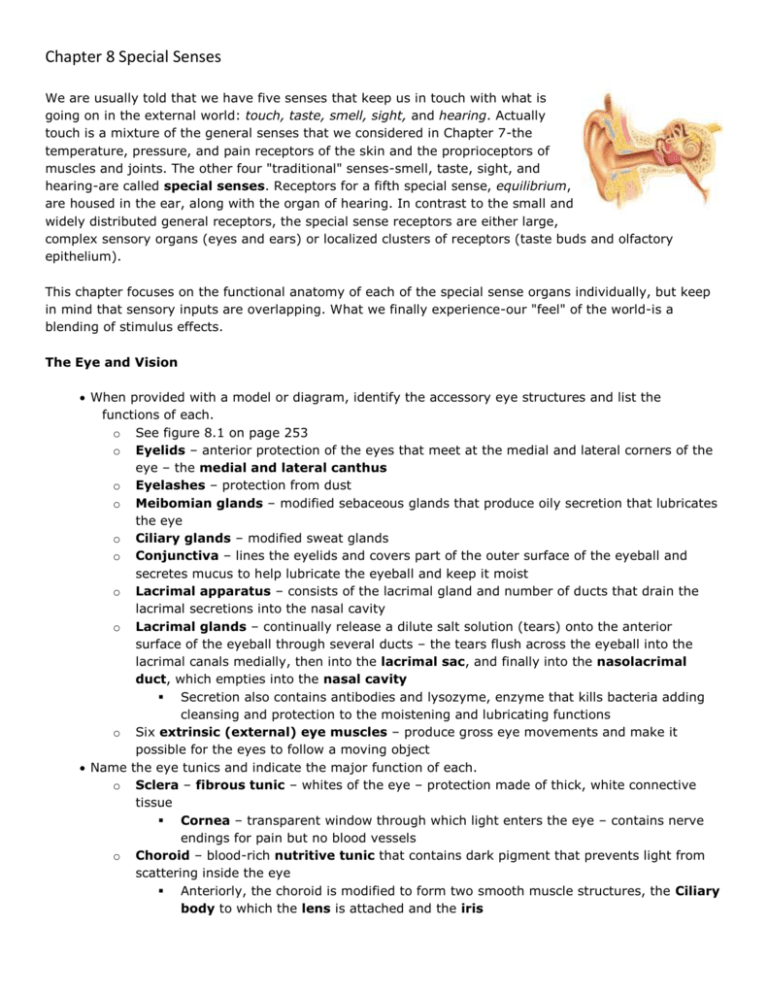
Chapter 8 Special Senses We are usually told that we have five senses that keep us in touch with what is going on in the external world: touch, taste, smell, sight, and hearing. Actually touch is a mixture of the general senses that we considered in Chapter 7-the temperature, pressure, and pain receptors of the skin and the proprioceptors of muscles and joints. The other four "traditional" senses-smell, taste, sight, and hearing-are called special senses. Receptors for a fifth special sense, equilibrium, are housed in the ear, along with the organ of hearing. In contrast to the small and widely distributed general receptors, the special sense receptors are either large, complex sensory organs (eyes and ears) or localized clusters of receptors (taste buds and olfactory epithelium). This chapter focuses on the functional anatomy of each of the special sense organs individually, but keep in mind that sensory inputs are overlapping. What we finally experience-our "feel" of the world-is a blending of stimulus effects. The Eye and Vision When provided with a model or diagram, identify the accessory eye structures and list the functions of each. o See figure 8.1 on page 253 o Eyelids – anterior protection of the eyes that meet at the medial and lateral corners of the eye – the medial and lateral canthus o Eyelashes – protection from dust o Meibomian glands – modified sebaceous glands that produce oily secretion that lubricates the eye o Ciliary glands – modified sweat glands o Conjunctiva – lines the eyelids and covers part of the outer surface of the eyeball and secretes mucus to help lubricate the eyeball and keep it moist o Lacrimal apparatus – consists of the lacrimal gland and number of ducts that drain the lacrimal secretions into the nasal cavity o Lacrimal glands – continually release a dilute salt solution (tears) onto the anterior surface of the eyeball through several ducts – the tears flush across the eyeball into the lacrimal canals medially, then into the lacrimal sac, and finally into the nasolacrimal duct, which empties into the nasal cavity Secretion also contains antibodies and lysozyme, enzyme that kills bacteria adding cleansing and protection to the moistening and lubricating functions o Six extrinsic (external) eye muscles – produce gross eye movements and make it possible for the eyes to follow a moving object Name the eye tunics and indicate the major function of each. o Sclera – fibrous tunic – whites of the eye – protection made of thick, white connective tissue Cornea – transparent window through which light enters the eye – contains nerve endings for pain but no blood vessels o Choroid – blood-rich nutritive tunic that contains dark pigment that prevents light from scattering inside the eye Anteriorly, the choroid is modified to form two smooth muscle structures, the Ciliary body to which the lens is attached and the iris The pigmented iris has a rounded opening, the pupil, through which light passes o Retina – sensory tunic – extends anteriorly only to the ciliary body – contains millions of receptor cells called rods and cones (together called photoreceptors – respond to light) Photoreceptors cells cover the entire retina except where the optic nerve leaves the eyeball at the optic disk, or blind spot Explain how rod and cone function differ. o Rods are most dense at the periphery, or edge of the retina and decrease in number as the center of the retina is approached – allow us to see in gray tones in dim light and they provide peripheral vision o Cones are densest in the center of the retina and decrease in number toward the retinal edge – discriminatory receptors that allow us to see the details of our world in color under bright light conditions – the fovea centralis, a tiny pit that contains only cones, is the area of greatest visual acuity, or point of sharpest vision There are three types of cones each responds to particular wavelengths of visible light – blue, green, red and green (called red cones as they are the only ones to respond to red light) Impulses arriving at the same time from more than one type of cone is interpreted as intermediate colors Describe image formation on the retina. o The image formed on the retina as a result of the light-bending activity of the lens is a real image – it is reverse from left to right, upside down (inverted), and smaller than the object Trace the pathway of light through the eye to the retina. o Cornea aqueous humor (through pupil) aqueous humor lens vitreous humor retina Discuss the importance of an ophthalmoscopic examination. o The ophthalmoscope is an instrument that illuminates the interior of the eyeball allowing the retina, optic disc, and internal blood vessels to be viewed o Certain pathological conditions such as diabetes, arteriosclerosis, and degeneration of the optic nerve and retina can be detected Define the following terms: accommodation, astigmatism, blind spot, cataract, emmetropia, glaucoma, hyperopia, myopia, and refraction. o Accommodation – the ability of the eye to focus specifically on close objects – the resting eye is set for distant vision o Astigmatism – results from unequal curvatures in different parts of the cornea or lens – results in blurry images because points of light are focused not as points on the retina but as lines – treated with special cylindrically ground lenses or contacts o Blind spot – when light from an object is focuses on the optic disk it disappears from our view and it cannot be seen o Cataracts – result when the lens becomes increasingly hard and opaque with old age – causes vision to become hazy and may eventually cause blindness in the affected eye – treatment is with lens transplants or special cataract glasses o Emmetropia – normal eye – focuses images correctly on the retina – have harmonious vision o Glaucoma – results from blockage of drainage of aqueous humor and pressure buildup that begins to compress the delicate retina and optic nerve – eventually causes pain and possibly blindness – occurs slowly without symptoms then later signs include seeing halos around lights, headaches, and blurred vision – treated with eyedrops (miotics), which increase the rate of aqueous humor drainage or with surgical enlargement of the drainage channel o Hyperopia – farsightedness – results when the parallel light rays from distant objects are focuses behind the retina – results when the eyeball is too short or a lazy lens – distant objects are seen clearly but nearby object look blurry – treated with convex corrective lenses that converge the light rays before they enter the eye o Myopia – nearsightedness – results when the parallel light rays from distant objects fail to reach the retina and instead are focused in front of it – distant objects appear blurry while nearby objects are in focus – results when the eyeball is too long, a lens is too strong, or a cornea is too curves – treated with concave corrective lenses that diverge the light rays before they enter the eye so they converge farther back o Refraction – the bending of light rays as they pass through the cornea, aqueous humor, lens and vitreous humor The refractive power of the cornea and humors is constant – the refractive powers of the lens can be changed by changing its shape (making it more or less convex) so light can be properly focused on the retina Trace the visual pathway to the optic cortex. o Optic nerve optic chiasma optic tract thalamus optic radiation visual cortex in occipital lobe of the brain Discuss the importance of the pupillary and convergence reflexes. o Photopupillary – results when the eyes are suddenly exposed to bright light and the pupils immediately constrict – a protective reflex that prevents excessively bright light from damaging the photoreceptors o Accommodation pupillary – results when the pupils constrict reflexively to view close objects – provides more acute vision o Convergence – a reflexive movement of the eyes medially when we view close objects – both eyes are aimed toward the near object being viewed The Ear: Hearing and Balance Identify the structures of the external, middle, and internal ear, and list the functions of each. o See figure 8.12 on page 265 o External – outer - ear Pinna – auricle – shell-shaped structure surrounding the auditory canal opening – collects and directs sound waves into the auditory canal (a function largely lost in humans) External auditory canal – short, narrow chamber carved into the temporal bone of the skull – inside contains ceruminous glands that secrete waxy, yellow earwax, or cerumen Sound waves eventually hit the tympanic membrane, or eardrum, and cause it to vibrate o Middle ear – tympanic cavity Small, air-filled cavity within the temporal bone flanked laterally by the eardrum and medially by a bony wall with two openings – oval window and the round window Auditory tube runs obliquely downward to link the middle ear cavity with the throat, and the mucosal lining the two regions are continuous – swallowing or yawning can open the auditory tube to equalize the pressure in the middle ear cavity with the atmospheric pressure to the eardrum can vibrate freely Ossicles – tiny bones which transmit the vibratory motion of the eardrum to the fluids of the inner ear – named for their shape Hammer (malleus), anvil (incus), and stirrup (stapes) When the eardrum moves, the hammer moves and transfers the vibration to the anvil, which passes it on to the stirrup, which presses on the oval window of the inner ear – movement at the oval window sets the fluids of the inner ear into motion, eventually exciting the hearing receptors o Inner – internal – ear Maze of bony chambers called osseous, or bony, labyrinth deep within the temporal bone and just behind the eye socket – has three subdivisions Cochlea – Vestibule – Semicircular canals Bony labyrinth is filled with a plasma-like fluid called perilymph – suspended in this is a membranous labyrinth, a system of membrane sacs that more or less follows the shape of the bony labyrinth, which contains a thicker fluid called endolymph Explain the function of the organ of Corti in hearing. o Contains the hearing receptors or hair cells o The receptor cells, positioned on the basilar membrane in the organ of Corti, are stimulated when their hairs are bent or tweaked by the movement of the gel-like tectorial membrane that lies over them – once stimulated, the hair cells transmit impulses along the cochlear nerve to the auditory cortex in the temporal lobe where interpretation of the sound, or hearing, occurs High-pitches sounds disturb receptor cells close to the oval window, low-pitched sounds stimulate specific hairs further along the cochlea Define sensorineural and conductive deafness and list possible causes of each. o Sensorineural deafness – occurs when there is degeneration or damage to the receptor cells in the organ of Corti, to the cochlear nerve, or to neurons of the auditory cortex – extended listening to excessively loud sounds – a problem of nervous system structures – hearing aids are less helpful in correcting o Conduction deafness – results when something interferes with the conduction of sound vibrations to the fluids of the inner ear – buildup of earwax, fusion of the ossicles, a ruptured eardrum, otitis media – hearing aids, which use skull bones to conduct sound vibrations to the inner ear can help Explain how one is able to localize the source of a sound. o Since sound usually reaches the two ears at different times, we hear in stereo, which helps us determine which direction the sound comes from Trace the route of sound waves through the ear and activation of the cochlear hair cells. o Pinna auditory canal eardrum hammer, anvil, stirrup oval window fluids in cochlear canals to excite the hair cells in the organ of Corti in the inner ear, sound waves must pass through air, membranes, bone, and fluid Describe how the equilibrium organs help maintain balance. o The sense of equilibrium responds to the various movements of our head – the receptors of the inner ear, sometimes called the vestibular apparatus, can be divided into two functional arms Static equilibrium – contains receptors called maculae that report on the position of the head with respect to the pull of gravity when the body is not moving (is static) – provide information on which way is up or down, they help us keep our head erect Each macula is a patch of receptor cells with their hairs embedded in the otolithic membrane, a gel or jellylike material containing otoliths, tiny stones made of calcium salts – as the head moves the otoliths roll in response to changes in the pull of gravity creating a pull on the gel, which in turn slides like a greased plate over the hair cells, bending the hairs and activating them sending an impulse along the vestibular nerve to the cerebellum of the brain Dynamic equilibrium – receptors found in the semicircular canals respond to angular or rotatory movements of the head, rather than to straight-line movements o – semicircular canals are oriented in the three planes of space so regardless of which plane one moves in, there will be receptors to detect the movement Within each membranous semicircular canal is a receptor region called a Crista ampullaris, which consists of a tuft of hair cells covered with a gelatinous cap called the cupula – when your head moves in an angular direction, the endolymph in the canal lags behind and moves in the opposite direction, pushing the cupula in a direction opposite to the body’s motion stimulating the hair cells and thus sending impulses are transmitted up the vestibular nerve to the cerebellum Both the static and dynamic equilibrium work together to maintain balance along with sight and Proprioceptors of the muscles and tendons Chemical Senses: Taste and Smell Describe the location, structure, and function of the olfactory and taste receptors. o Olfactory receptors – receptors for the sense of smell – occupy an area in the roof of each nasal cavity – since air entering the nasal cavities must make a hairpin turn to enter the respiratory passageway below, sniffing causes more air flow superiorly across the olfactory receptors, intensifies the sense of smell Olfactory receptor cells are neurons equipped with olfactory hairs, long cilia that protrude from the nasal epithelium and are continually bathed by a layer of mucus secreted by underlying glands – when the receptors are stimulated by chemicals dissolved in the mucus, they transmit impulses along the olfactory filaments, which collectively make up the olfactory nerve to the olfactory cortex of the brain Only need a few molecules can activate them Olfactory pathways are closely tied into the limbic system (emotional-visceral part of the brain) making olfactory impressions long-lasting and very much a part of our memories and emotions Name the four basic taste sensations and list factors that modify the sense of taste. o Taste buds, specific receptors for the sense of taste, are scattered in the oral cavity, mostly on the tongue and a few found on the soft palate and inner surface of the cheeks The dorsal tongue surface is covered with small peg-like projections, or papillae of three types: sharp filiform papillae and the rounded fungiform and circumvallate papillae – the taste buds are found on the sides of the circumvallate papillae and on the fungiform papillae The specific cells that respond to chemicals dissolved in the saliva are epithelial cells called gustatory cells, which are surrounded by supporting cells in the taste bud Their long microvilli – the gustatory hairs – protrude through the taste pore, and when they are stimulated, they depolarize and impulses are transmitted to the brain There are four basic taste sensations Sweet receptors respond to substances such as sugars, saccharine, and some amino acids – possibly the OH- group – tip of tongue Sour receptors respond to hydrogen ions (H+) or the acidity of the solution – sides of the tongue – back of the tongue Bitter receptors respond to alkaloids Salty receptors respond to metal ions in solution – tip of tongue o Taste is affected by many factors Our sense of taste depends on stimulation of our olfactory receptors by aromas The temperature and texture of food can enhance or spoil its taste Spicy foods like chili peppers actually excite pain receptors in the mouth Developmental Aspects of the Special Senses Describe changes that occur with age in the special sense organs. o Sense of sight – presbyopia begins to set in around the age 40 – results from decreasing lens elasticity that accompanies aging making it difficult to focus for close vision (farsightedness) – lacrimal glands become less active and the eyes tend to become dry and more vulnerable to bacterial infection and irritation, the lens loses its crystal clarity and becomes discolored and the dilator muscle of the iris become less efficient so the pupils are always somewhat constricted reducing the amount of light reaching the retina reducing visual acuity – glaucoma and cataracts can also lead to blindness o Sense of hearing – by the age of 60, gradual deterioration and atrophy of the organ of Corti begins and leads to a loss in the ability to hear high times and speech sounds – presbycusis, a type of sensorineural deafness – otosclerosis occurs when the ossicles fuse leading to hearing loss o Sense of taste and smell – increase with age as their emotional responses to specific odors increases until age 40 when the abilities diminish reflecting the gradual decrease in the number of these receptor cells – over half of people over 80 cannot smell and their sense of taste is poor
